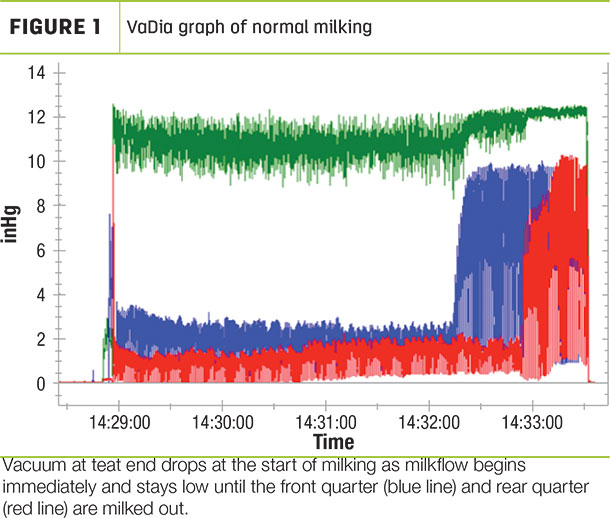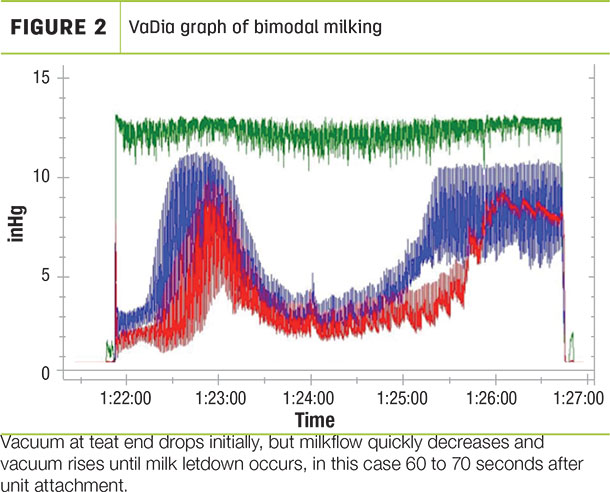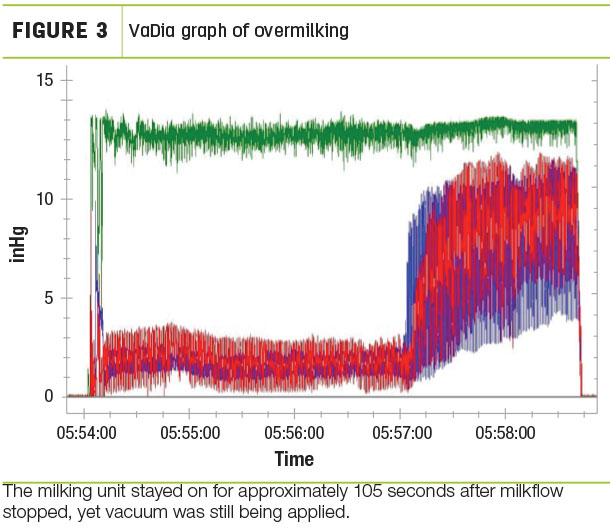You know how irritating it is to get a pebble in your boot. Each step reminds you there is something down there. Maybe you are like me, and you think at first it will go away, or at least find a place in your boot that is less irritating.
Then after that proves to be wrong, I finally do what I should have done from the start – take my boot off and dump out the pebble, which, by then, I have figured is going to be the size of a rock.
What if milking were something like this for your cows? What if there was a pebble in the process every time they came to the parlor? That pebble could be irritating your cows and making their milking experience less than optimal. If there are systematic problems during milking, they are multiplied two or three times per day.
The best thing to do is to make the changes necessary to eliminate the pebble in the milking process.
At Michigan State University, we have been working with herds to do that by using a relatively new tool – the VaDia vacuum diagnostic recorder from BioControl. Through a USDA NIFA-funded project, the milking of more than 10,000 cows have been evaluated in a variety of parlors or barns in Michigan, Pennsylvania and Florida.
The recorder has four channels and will record vacuum in the chamber mouthpiece of a front and rear teat as well as in the cluster and pulsation tube. Vacuum is the inverse of milk flow, so we can tell exactly what is happening at the teat end and cluster during milking.
Using multiple recorder units attached to the milking units at various stalls in the parlor, we can get data for 30-plus cows each milking, enabling us to better understand what is going on.
Through this evaluation, we have identified two principal problems, or pebbles, during milking: bimodal milking as a result of insufficient stimulation of the teats or inadequate lag time and overmilking.
The milking process should be designed to work with the cow. It should take advantage of the cow’s physiology. We have long known physical stimulation of the teats results in the release of oxytocin by the cow’s pituitary gland. But how much stimulation is necessary and what is stimulating?
After the cow is stimulated, it takes approximately 60 seconds for oxytocin to cause milk letdown. When a milking unit is attached 60 to 120 seconds after sufficient stimulation, milk flow will begin and not stop until the cow has finished milking. In Figure 1, we see an example of a good milking experience for the cow.

As milk flow starts, vacuum drops (they are inversely related) and stays low until milk flow stops. Then the unit comes off.
When milk flow starts, then stops and restarts after 30 to 60 seconds, we call that bimodal or biphasic milking. It occurs when the milking process is not coordinated with the cow’s physiology, either because there has been too little stimulation or too little time between stimulation and milking unit attachment.
The milk flow that starts is just the milk present in the ducts and, when it is milked out, flow does not begin again until letdown occurs. In the meantime, vacuum is being applied to a “dry” teat. Figure 2 is the graph of a cow with bimodal milking.

What is normal? In a Michigan State University study, 50 percent of herds had nearly a quarter of their cows with bimodal milking. However, one-third of herds were able to achieve 10 percent or less of the herd with bimodal milking. We believe that should be the goal.
What does it matter? Is that pebble really causing any pain? There are several negative consequences from bimodal milking: uncomfortable cows as a result of vacuum being applied with no milk flow, congestion in the teat end that may decrease the diameter of the teat canal, potential for increased teat-end roughness and possibility of reduced milk yield.
The last consequence should draw attention. Dr. Ron Erskine notes milking time did not increase when cows had bimodal milking. In addition, the rate of milk flow did not increase during milking, so he suspects cows gave less milk when they experienced bimodal milking. A preliminary study supports that.
Bimodal milking is usually a protocol problem. Cows require approximately 10 seconds of physical stimulation to the teats before oxytocin will be released. The stimulation (brushing teats, manually massaging dip into teats, forestripping) needs to occur in the first visit to the cow so there is sufficient lag time (at least 60 seconds).
The second pebble identified in the process was overmilking – leaving a milking unit on more than 30 seconds after milk flow is low (Figure 3).

In the Michigan study, 44 percent of herds had 30 percent or more of their cows overmilked. The goal should never be to get the last drop of milk out of a cow and, frankly, we have seen automatic takeoffs set too “dry.”
We have also seen too many employees using the “manual” override setting on automatic takeoff units. If this is happening on your farm, look for the underlying reasons why the manual override setting is being used. Correct those and then coach employees to avoid using this setting.
Overmilking makes milking shifts longer. Even if each side of a parlor turn is only extended by one to two minutes, that could mean 15 to 30 minutes longer per milking. That is extra time cows spend away from feed and beds as they stand in the holding area. That will impact production.
The vacuum diagnostic recorder tool is in use by trained veterinarians and equipment specialists around the country. Even if a farm is meeting their somatic cell count goal, the milking process could contain those pebbles of problems that will impact cow udder health and profitability. Ask your veterinarian if they can evaluate your milking. The results are a great teaching tool for employees.
On many dairy farms, employees do most of the milking. Though they have been trained, employee turnover works against consistency. Protocol drift happens. When employees are pushed to complete milking in an unrealistic timeframe, when milking shifts are long, when employees shortcut protocols because they don’t understand the rationale behind them, problems will arise.
View these problems as those of management and employees together. Solve them together and monitor the results together. Problems are an opportunity for everybody to get better. ![]()

-
Phil Durst
- Sr. Extension Dairy Educator
- Michigan State University Extension
- Email Phil Durst






